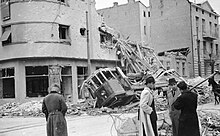Air raid on Belgrade
With the air raids on Belgrade ( company criminal court ) by the Wehrmacht on April 6th and 7th, 1941, the German Balkan campaign began .
backgrounds
On March 27, 1941, Hitler ordered the Luftwaffe in “Directive No. 25” to “destroy the capital Belgrade by continuing day and night attacks” at the beginning of the Yugoslavia campaign . Without prior declaration of war or ultimatum , the armies of National Socialist Germany and its allies Italy and Hungary attacked the state of Yugoslavia at 5:15 a.m. on April 6, 1941 . Although the Yugoslav government had declared Belgrade an open city , the capital was largely destroyed within two days.
course
On March 31, 1941, the Commander-in-Chief of Air Fleet 4 , Alexander Löhr , issued the "Order for Air Warfare Yugoslavia". Aircraft associations in Zwölfaxing , Wiener Neustadt , Vienna- Aspang, Graz and Arad were given the task of carrying out the “destruction of Belgrade by a major attack”. On April 6th and 7th, 484, according to other sources 611 Stukas and bombers bombed the capital in five waves, which had no anti-aircraft guns and had been declared an open city . The campaign ran under the code name "Company Criminal Court". The first wave of attacks was supposed to devastate the city and hit the population. It was supposed to cause major fires in order to make it easier to find the target for the planned night mission. The second wave should then hit military installations and administrative centers.
From a strategic point of view, air strikes by a few Bristol Blenheim bombers of the Yugoslav Air Force on targets in Austria only had a symbolic character, for example two of these planes dropped a few bombs on utilities in Graz on April 6, causing death and minor property damage.
consequences
Thousands of people were killed when a total of 382 tons of explosives, 448 incendiary and fragmentation bombs were dropped . The exact number of victims is still controversial to this day, the estimates vary widely and range from 1,500 to 17,000 or even 30,000. Official Yugoslav figures released after the war indicate at least 2,271 victims. Of the approximately 20,000 houses in Belgrade, 9,000 were destroyed or damaged. Large parts of the historic city center of Belgrade were destroyed, including numerous churches such as St. Mark's Church on the Tašmajdan Plateau, built in 1835, synagogues in the Jewish quarter of Dorćol and the Belgrade government quarter. Löhr's strategy of destroying the administrative and logistical center of a country, which was already used during the bombing of Warsaw, was also successful in Yugoslavia. The Yugoslav air force was eliminated, the government had to flee Belgrade and was no longer able to establish contact with its military staffs and agencies. On the evening of April 12th, the mayor of Belgrade handed over the city to a German troop led by Fritz Klingenberg .
The commanding general of the Air Force (since May 3, 1941 Colonel General ), Alexander Loehr , was after the war by a Yugoslav court sentenced to death , and on February 26, 1947 executed .
Belgrade was attacked several times by allied bomber groups during the Second World War . The first attack was carried out on April 16 and 17, 1944 (Orthodox Easter) by 600 bombers from the US Air Force and the RAF and killed around 1200 civilians. The last attack took place on September 3, 1944.
See also
literature
- Antony Beevor: The Second World War. C. Bertelsmann, Munich 2014. (First edition: The Second World War. W & N, London 2012.)
- Detlef Vogel: Operation “criminal court”. The ruthless bombing of Belgrade by the German air force on April 6, 1941. In: Gerd R. Ueberschär , Wolfram Wette (Ed.): War crimes in the 20th century. Primus , Darmstadt 2001, ISBN 3-89678-417-X , pp. 303-308.
Web links
- Carl Savich: Belgrade 41: Hitler's Attack (Serbian representation)
Individual evidence
- ↑ Antony Beevor: The Second World War. Munich 2014, p. 188.
- ^ Janusz Piekałkiewicz : Air War, 1939–1945. Südwest-Verlag , Munich 1978, ISBN 3-517-00605-X , p. 138.
- ^ A b c Walter Manoschek : "Serbia is Jew-Free": Military Occupation Policy and the Extermination of Jews in Serbia 1941/42. Volume 38 of contributions to military and war history. Oldenbourg , Munich 1995, ISBN 3-486-56137-5 , p. 18 f.
- ↑ BRISTOL BLENHEIM The Yugoslav Story 1937 - 1958, Publisher Aleksandar M. Ognjević - Zemun, Serbia, pages 57 to 70 ISBN 978-86-917625-0-6 .
- ^ Air raids by the Yugoslav Air Force on April 6 and 7, 1941 , website regiowiki.at, accessed on December 6, 2014.
- ^ Emergency landing of a Bristol Blenheim near Markt Allhau , website regiowiki.at, accessed on December 6, 2014.
- ^ Erwin Pitsch: Alexander Löhr. Austrian Militia Publishing House, Salzburg. Volume 2: The Air Fleet Chief. 2006, ISBN 978-3-901185-22-9 , p. 247.
-
^ Rolf-Dieter Müller : The bombing war 1939-1945. Links Verlag, Berlin 2004, ISBN 3-86153-317-0 , p. 86.
Gerhard Schreiber , Bernd Stegemann , Detlef Vogel: Germany and the Second World War . Volume 3: The Mediterranean, South-East Europe, and North Africa 1939–1941 (From Italy's Declaration of Non-Belligerence to the Entry of the United States into the War.) Military History Research Office , Oxford University Press , 1995, ISBN 0-19 -822884-8 , p. 498.
Günter Bischof, Fritz Plasser (Ed.): New perspectives on Austrians and World War II. Volume 17 of Contemporary Austrian studies. Transaction Publishers, New Brunswick, NJ 2009, ISBN 978-1-4128-0883-5 , p. 41. - ↑ Belgrade Historical Archive: Bombardovanje Beograda u drugom svetskom ratu. Belgrade 1975, pp. 1-5.

